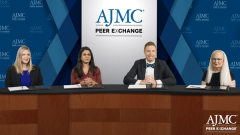
Biosimilar Administration Considerations Impacting Patient Experience
Panelists discuss reference biologic and biosimilar concentrations as well as the importance of citrate-free, less frequent injectable medications.
Episodes in this series

This is a video synopsis/summary of a panel discussion involving a multidisciplinary team of experts: Ryan Haumschild, PharmD, MS, MBA; Alice B. Gottlieb, MD, PhD; Bincy Abraham, MD, MS; Jamie T. Brogan, APRN; and Vibeke Strand, MD. The discussion delves into critical aspects of rheumatologic treatment strategies, providing valuable insights into evolving practices.
Haumschild initiates the discourse by emphasizing the advancements in biosimilars, focusing particularly on adalimumab (Humira). The discussion centers on concentration differences, with a spotlight on FDA-approved biosimilars featuring varying strengths. This prompts Brogan to elaborate on the practical implications, such as altered dosing regimens and the resultant impact on patient adherence. The transition to higher concentrations, notably in the gastrointestinal setting, emerges as a game-changer, reducing barriers and improving the overall patient experience.
The conversation takes an intriguing turn as Gottlieb sheds light on challenges in dermatology, addressing specifically hidradenitis suppurativa. Gottlieb introduces the off-label use of infliximab (Remicade), highlighting its potential efficacy in weight-based dosing. Notably, Strand brings attention to the differences in practice settings, emphasizing rheumatologists’ preference for self-administered subcutaneous therapies due to reimbursement issues associated with intravenous treatments.
Abraham underscores the significance of concentration in patient care, particularly in the context of gastrointestinal conditions. The transition to higher concentrations proves beneficial in addressing obstacles associated with invasive weekly medications.
Video synopsis is AI-generated and reviewed by AJMC editorial staff.
Newsletter
Stay ahead of policy, cost, and value—subscribe to AJMC for expert insights at the intersection of clinical care and health economics.








































